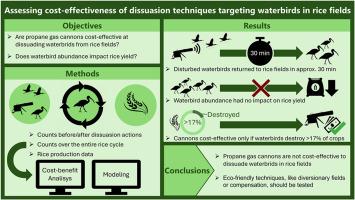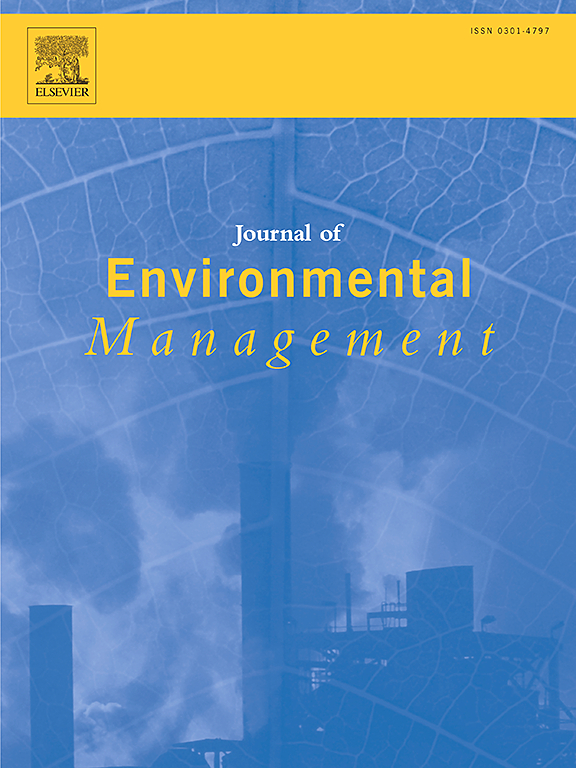Assessing cost-effectiveness of dissuasion techniques targeting waterbirds in rice fields
IF 8.4
2区 环境科学与生态学
Q1 ENVIRONMENTAL SCIENCES
引用次数: 0
Abstract
In a scenario of global wetland loss, rice fields are becoming vital habitats for waterbirds, often offering abundant and predictable food resources. However, the increasing presence of waterbirds in rice fields is exacerbating human-wildlife conflicts, as birds are seen as pests by farmers due to the damage they perceive the birds inflict to the crops. To tackle this situation, farmers use dissuasion methods like propane gas cannons, but its effectiveness in reducing damage is often not quantified. In this study we evaluate the cost-effectiveness of propane gas cannons in deterring waterbirds from rice fields and test if there is a correlation between bird abundance in a given field during rice growth and rice yield in the same field. Waterbird counts were conducted before and after dissuasion actions targeting Glossy ibis and White stork in a major rice production area in Portugal. To assess the potential magnitude of damage reduction gained through dissuasion, we estimated the time elapsed between dissuasion events and the reestablishment of bird numbers in the disturbed fields. The economic cost of dissuasion was compared with the estimated gains from reduced damage. Results showed that on average, waterbird numbers recovered ca. 30 min after dissuasion, leading to an estimated 0.78% reduction in crop damage. The final yield of rice production was modelled considering all gains and costs involved in dissuasion actions in relation to an increase in dissuasion efforts for 11 scenarios of potential waterbird damage (0–20%). For dissuasion to be cost-effective, waterbirds would need to destroy at least 17% of the crops, far more than any damage previously recorded in Europe. Also, we found that the abundance of waterbirds in a rice field does not affect rice yield. We suggest that efforts to reduce damage should shift to more cost-effective and environmentally friendly methods, such as diversionary fields or economic compensations to farmers. This can enhance the economies of rice-dependent countries and reduce conflicts, ultimately reconciling rice agriculture with biodiversity conservation.

评估针对稻田水鸟的劝阻技术的成本效益。
在全球湿地不断减少的情况下,稻田正成为水鸟的重要栖息地,通常能提供丰富且可预测的食物资源。然而,水鸟越来越多地出现在稻田里,加剧了人类与野生动物之间的冲突,因为农民认为鸟类会对作物造成损害,因此将鸟类视为害虫。为了应对这种情况,农民们使用丙烷气炮等方法进行劝阻,但这种方法在减少损害方面的效果往往无法量化。在这项研究中,我们评估了丙烷瓦斯炮在阻止水鸟离开稻田方面的成本效益,并测试了水稻生长期间特定田块的鸟类数量与同一田块的水稻产量之间是否存在相关性。在葡萄牙的一个主要水稻产区,针对朱鹭和白鹳采取劝阻行动前后,对水鸟进行了计数。为了评估劝阻行动可能减少的损失程度,我们估算了劝阻行动与受干扰田地鸟类数量恢复之间的时间间隔。我们将劝阻的经济成本与减少损害的估计收益进行了比较。结果表明,平均而言,水鸟数量在劝阻后约 30 分钟恢复,从而导致作物损害估计减少 0.78%。在 11 种水鸟可能造成的损害(0-20%)情况下,考虑到劝阻行动涉及的所有收益和成本,对水稻的最终产量进行了模拟。要使劝阻具有成本效益,水鸟至少需要破坏 17% 的农作物,这远远超过了欧洲以前记录的任何破坏程度。此外,我们还发现水鸟在稻田中的数量不会影响水稻产量。我们建议,减少破坏的努力应转向更具成本效益和环境友好型的方法,如分流田或对农民进行经济补偿。这既能提高水稻依赖国的经济效益,又能减少冲突,最终实现水稻农业与生物多样性保护的协调。
本文章由计算机程序翻译,如有差异,请以英文原文为准。
求助全文
约1分钟内获得全文
求助全文
来源期刊

Journal of Environmental Management
环境科学-环境科学
CiteScore
13.70
自引率
5.70%
发文量
2477
审稿时长
84 days
期刊介绍:
The Journal of Environmental Management is a journal for the publication of peer reviewed, original research for all aspects of management and the managed use of the environment, both natural and man-made.Critical review articles are also welcome; submission of these is strongly encouraged.
 求助内容:
求助内容: 应助结果提醒方式:
应助结果提醒方式:


